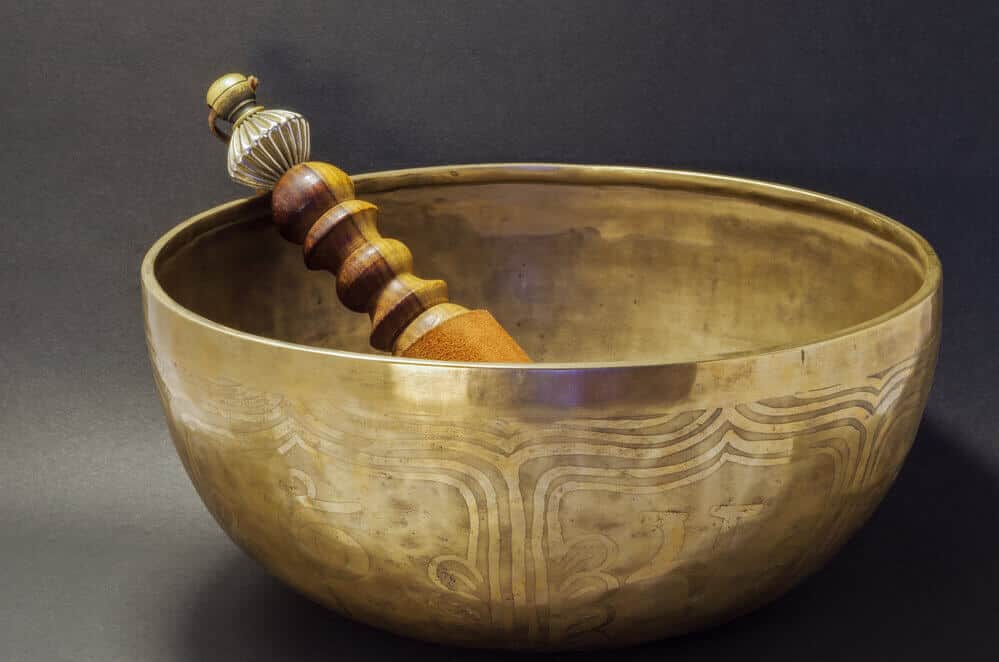Using a singing bowl can be a powerful tool for relaxation and meditation. As someone who has been using singing bowls for years, I can attest to their transformative effects on the mind and body. However, whether you are new to singing bowls or have used them for a while, there are a few key steps to remember to get the most out of your practice.
What is a Singing Bowl?
A singing bowl is an instrument that produces sounds when struck or played with a mallet or striker. It is a type of standing bell placed on a cushion or mat and played by striking it or rubbing its rim with a mallet or striker.
The singing bowls’ beginnings are believed to have originated in the Himalayan region. Tibetan Buddhists and other spiritual practitioners have used them for centuries in meditation, sound healing, and other spiritual practices.
A singing bowl is available in various sizes and shapes, and they are created from brass, bronze, or crystal and produce a range of sounds, from deep, low tones to high, bright tones. The sound produced is calming and relaxing on the mind and body and can promote deep relaxation, stress relief, and healing.
In addition to their spiritual and therapeutic uses, singing bowls are also used for musical purposes. They are often used in soundtracks for movies, TV shows, videos and other media, as well as in live performances by musicians and performers.
Choosing a Singing Bowl
The main things I look at and steps I take when selecting and using a singing bowl include size, material and sound.
- Size – The size of the singing bowl is an essential factor to consider. Generally, the larger the bowl, the deeper the sound. However, larger bowls can be more challenging to play and require more effort to get a good sound. On the other hand, smaller bowls are easier to play and are great for beginners or those who want a higher-pitched sound.
- Material – Singing bowls are made from various materials, including metal, crystal, and wood. Metal bowls are the most common and can be made from different types of metals, such as bronze, brass, or copper. Crystal bowls are made from quartz crystal, producing a clear, pure sound. Wood bowls are less common but can create a warm, mellow sound.
- Sound – The sound of the singing bowl is the most essential factor to consider. Each bowl has its own unique sound and tone, so it’s important to listen to the bowl’s sound before purchasing it. When choosing a singing bowl, I like to strike the bowl with a mallet and listen to the sound it produces. I also try different mallets to see how they affect the bowl’s sound.
Preparing to Use Your Singing Bowl
First and foremost, choosing a singing bowl that resonates with you is important, which may involve trying out different bowls and listening to the sound they produce to find one that feels right. Then, once you have your bowl, create a quiet, peaceful space where you can practice without distractions. From there, you can explore different techniques for using your singing bowl to promote relaxation and inner peace. Learn more about sound healing by click this link to our guide Leisure And Sound Healing
a. Setting an Intention
Set an intention before using your singing bowl, but it should resonate with you and your current needs. For example, your intention may be to release negative energy, invite positive energy, or relax and let go of stress. Consider your goal and what you want to achieve with your singing bowl, and set your intention accordingly.
b. Clearing the Space
Clearing the space around you is essential in preparing to use your singing bowl. Clearing can be done in various ways, such as smudging with sage, lighting candles, or opening windows to let in fresh air. The idea is to create a peaceful, calming space that allows you to be present and focus on your singing bowl practice entirely. So, take a few moments to clear the area around you before you begin.
c. Positioning the Bowl
Once you have set your intention and cleared the space, it’s time to position your singing bowl. Place the bowl on a flat, stable surface like a table or cushion. You can place the bowl on a pillow or mat if you are sitting on the floor. Ensure the bowl is within easy reach, and you can comfortably reach the rim with your mallet. If necessary, take a moment to adjust the bowl’s position to feel comfortable and natural.
By following these simple steps, you’ll be well-prepared to use your singing bowl for meditation, relaxation, or any other purpose that resonates with you. Remember to take your time, stay focused, and enjoy the process.
Striking the Bowl
1. Holding the Mallet
When using a singing bowl, the mallet is as vital as the bowl itself. To strike the bowl, you will need to hold the mallet correctly. Here’s how:
- Hold the mallet with your dominant hand.
- Next, wrap your fingers around the base of the mallet and place your thumb on the top.
- Ensure your grip is firm but not tight, as you want the mallet to move easily.
2. Striking the Bowl
Once your hold on the mallet is firm, it’s time to strike the bowl. Here are the steps to follow:
- Hold the bowl with your non dominant hand and make sure the bowl is resting on a flat surface.
- With your dominant hand, bring the mallet to the bowl’s rim.
- Using a smooth, fluid motion, strike the bowl’s rim with the mallet. You should hear a clear, ringing sound.
- If you don’t get a clear sound, try adjusting the angle of the mallet or the pressure used to strike the bowl.
Remember, the vibration of the bowl’s material creates the sound of the singing bowl. So, strike the bowl to create a precise, even vibration. With some practice, you can create beautiful, harmonious sounds with your singing bowl.
Playing the Bowl
a. Circling the Mallet
Hold the mallet between your thumb and first two fingers when playing a singing bowl, with the padded end of the mallet resting on your palm. To start playing the bowl, take the mallet, and rub it in a circular fashion around the bowl in a clockwise motion. I apply light pressure initially and gradually increase it as the sound grows louder and more sustained.
b. Adjusting the Pressure
I adjust the pressure I apply to the bowl’s rim with the mallet to create different tones and sounds. If I want a higher-pitched sound, I use more pressure and move the mallet faster around the rim. If I wish a lower pitched sound, I apply less pressure and move the mallet slower around the rim.
Experiment with different pressures and speeds to find the sweet spot that produces your desired sound. Practice will be needed to get the hang of playing the bowl and creating different pitches and sounds, but with time and patience, you can create beautiful, soothing sounds with your singing bowl.
Cleansing and Storing Your Singing Bowl
When using a singing bowl, you need to keep it clean and well maintained. Proper cleansing and storing will ensure the longevity and effectiveness of your singing bowl. The steps that I follow to cleanse and store my singing bowl include the following:
- First, I wipe the bowl with a clean, dry microfibre or cotton cloth to remove dirt, dust or debris.
- Then, I fill the singing bowl with warm water and dish soap; a few drops are needed to remove the grime.
- Next, I use a soft cloth to gently scrub the bowl, thoroughly cleaning the inside and outside. After rinsing it with clean water, I dry it with a towel.
- To further cleanse and purify the bowl, I like to place it in the sun for a few hours. The sun’s energy helps to remove any negative energy that may have accumulated in the bowl.
- If it’s not possible to place the bowl in the sun, use a sage smudge stick to cleanse it. Light the smudge stick and hold it under the bowl, allowing the smoke to flow over and around it.
- Once the bowl is clean and purified, store it in a safe place. I use a soft cloth to wrap the bowl and place it in a protective bag or box, which helps to prevent any damage to the bowl and keeps it free from dust and debris.
By following these simple steps, I can ensure that my singing bowl stays clean, pure, and well-maintained.
Final Thoughts
Using a singing bowl is an excellent way to promote relaxation and inner peace. With the right preparation, positioning, striking techniques, and cleansing routine for your singing bowl you can reap all of its benefits. It may take some practice and dedication before you master it fully but with patience and perseverance you will be able to enjoy the calming sounds that come from using a singing bowl.






